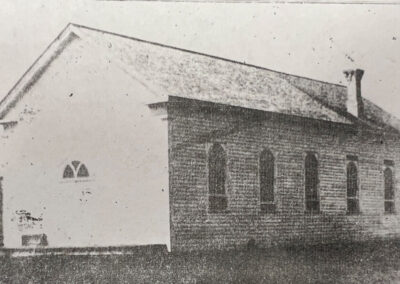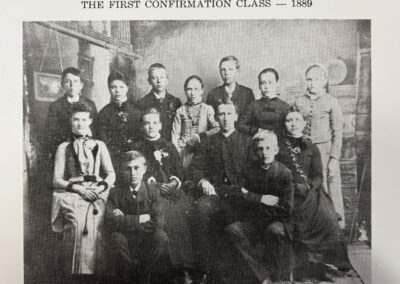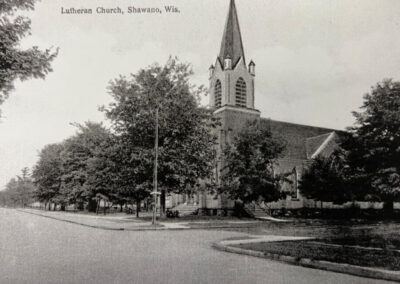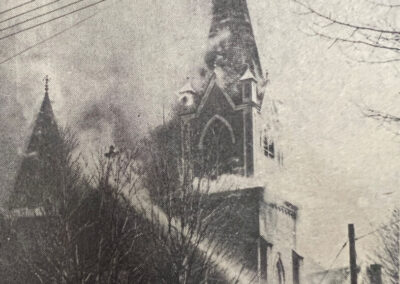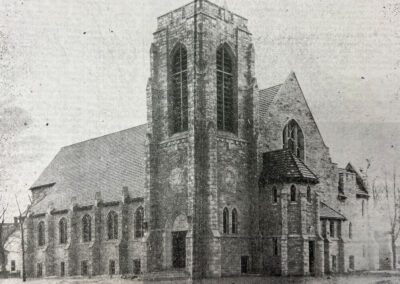Photo Gallery
The first confirmation class of St. James Lutheran School 1889. Top row, left to right: Emil Mielke, Emma Klebesadel (Mrs. Wm. Hoffman), Fred Steinberg, Minnie Mittlestadt, Albert Dallman, Frieda Thomas (Mrs. John Schenk), Anna Blank (Mrs. Walch). Middle row: Emma Weber, Ollie Krause (Mrs. John Wilbur), Rev. Theo, Nickel, Clara Garbrecht (Mrs. Clara Meyer). Front Row: Otto Regling, William Zingler, Herman Krumbach, Anna Wolf.
Notes
150th Annivesary of St. James Lutheran Church
Shawano, Wisconsin
St. James Lutheran congregation is celebrating it’s 150th anniversary in 2023. We thought it important to outline the early history of the church and congregation in Shawano Wisconsin.
As we reflect on Shawano’s growth since the late 1800’s it’s important to note the vital role churches played in the progress of our community. It was a great hardship for the people of Shawano to live without religious service early in the formation of the county and city.
The beginning of St. James congregation dates back to the year 1863 when the sainted Rev. P. H. Dicke, pioneer missionary and founder of twenty-four congregations in this vicinity, came to Shawano from Belle Plaine, where he was stationed at the time, to serve a group of German Lutherans. Pastor Dicke served St. James’ until 1879. The local congregation was organized and incorporated on May 11, 1873. In 1879 the Rev. C. F. Ebert, who succeeded Pastor Dicke at Belle Plaine, served St. James until 1888. At that time our congregation numbered 24 voting and 135 communicant members. The congregation at this time was conducting services in a frame building on South Union Street.
In 1888 the small but active congregation became self-supporting when it called its first resident pastor, the Rev. Theo. Nickel. Pastor Nickel was installed on October 7, 1888 by Pastor Wm. Hudtloff. Pastor Nickel started a parochial school, instructing the children in the first parsonage located on South Union Street. He served as pastor and teacher until 1898. In 1901 Pastor Nickel received and accepted a call to Eudenda, Australia. At this time the congregation numbered 425 communicant members.
On June 4, 1901, Rev. E. Hanow, who had left the congregation in Eudenda, Australia for health reasons, was installed as the new pastor of St. James by Rev. Nickel. In 1906, Pastor Hanow followed a call to Batavia, Wisconsin. During his pastorate, a parsonage on Randall Street was erected. The congregation then numbered 475 communicants.
Rev. F. F. Selle became the next pastor, coming from the Wittenberg Lutheran Academy where he had been an instructor. He was installed May 27, 1906. The blessing of the Lord crowned the faithful labors of Pastor Selle abundantly and the congregation grew in knowledge and numbers.
Services were conducted in the original small frame building on Union Street until a new, more substantial church was bult and dedicated in 1907.
In 1909 Mr. B. F. Koepsell was installed as the second called teacher. At his time the congregation became affiliated with the Lutheran Church-Missouri Synod. Since 1910 the congregation had English services. St. James then experienced a period of rapid growth and by 1911 it numbered 167 voting members with 141 pupils enrolled in the school. The year 1911 marked the redecorating of the interior of the church and the installation of sewer and water systems on Lincoln and Andrews Streets. In 1912, the congregation had authorized the opening of a third classroom and the use of contribution envelopes for the treasury of the congregation.
Mr. Paul Elbert was called in 1913 to replace Mr. Gehner, who had followed a call to Wittenberg. In 1914, the sister congregation at Town of Richmond became self-supporting and called their first resident pastor, thereby relieving Pastor Selle to devote his energy to St. James. In 1915, a new $3300 organ was dedicated which was paid in full.
On Easter Sunday, April 12, 1936, the school building was almost completely destroyed by fire. The congregation resolved to erect a new building which was dedicated on February 7, 1937.
In 1938, the Rev. N. P Ullig accepted a call into the Deaf-mute Mission at St. Louis. He preached his farewell sermon on August 14. He was succeeded by the Rev. Walter Schroth, who had served as assistant pastor since 1936. In 1941, Mr. Ruprecht and Mr. Eric Albers, who had been teaching since 1927 and 1928 respectively, followed calls to other congregations and Mr. A. Reuter was called. Mr. Reuter remained but one year and was replaced by Mr. Walter Gerdes in 1942.
On May 1, 1943, a fire destroyed the beautiful church which had served the congregation since its dedication in 1907. The last function in the church was the morning wedding rehearsal of Isabel Priem and Frederick Kruse. Their wedding was performed later that afternoon on the lawn of the Samuel Priem home because by that time the church was a mass of smoldering ruins. It was the second fire loss to the congregation in seven years. The school fire occurred in 1936. The 1943 fire, however, posed a greater problem. The War Production Board had claimed a majority of the building materials available to be used in the war effort. It was not until the end of the war that rebuilding could begin, although funds and materials were being collected in the meantime. On August 5, 1945, the cornerstone of the new church was laid. From May 1, 1943 to May 4, 1947, services were conducted in the school hall.
On May 3, 1953, the congregation marked its 80th Anniversary. At this time, it was the second largest parish in the Lutheran Church – Missouri Sy nod, numbering 3,983 members and 2,905 communicants. The Christian Day School enrollment was 366 pupils, staffed by a faculty of nine under the direction of Mr. Walter Gerdes, principal.
In 1954 and 1956 two new parsonages were built. The former was on Maurer and Lincoln streets and was first occupied by the Pastor Uttech family, the latter situated on Andrews Street, facing the church, was occupied by the Pastor Parsch family.
On September 11, 1955, the Rev. L. P. Buelow was ordained and in-stalled. This was the beginning of St. James’ three-man ministry. By this time the congregation had attained the distinction of being the largest in the Synod, numbering 3023 communicant members.
It was at his time that Mr. Gerdes accepted a call to Howard Lake, Minn. and Mr. W. E. Jiede, a member of the faculty, was elected to serve as principal. He served until August 1965, when after 17 years at St. James and 30 years in the teaching ministry, he chose to prepare himself for the preaching ministry by enrolling at Concordia Seminary.
St. James Lutheran congregation continues right up to today, utilizing the church built in 1947 for services.

